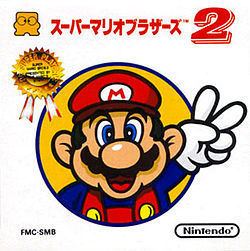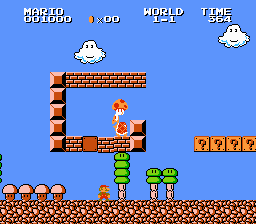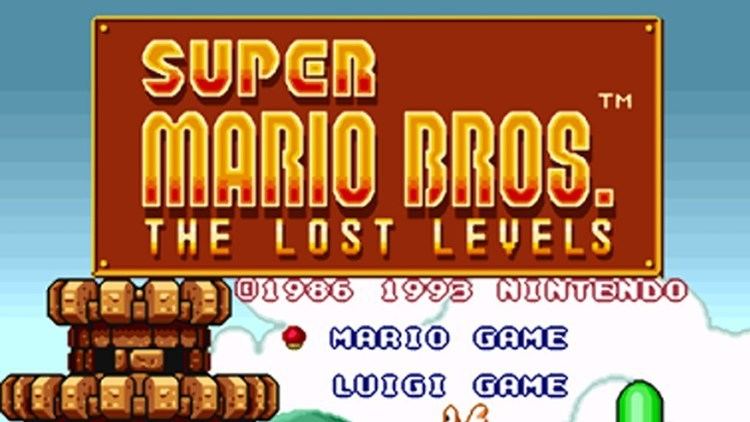7 /10 1 Votes7
7.6/10 FreeROMS | 6.5/10 GameSpot Genre(s) Platform, action Initial release date 3 June 1986 | |||||||||||||||||||||||||||||||||
 | ||||||||||||||||||||||||||||||||||
Developers Nintendo, Nintendo Entertainment Analysis & Development Similar Mario Series games, Nintendo games, Platform games | ||||||||||||||||||||||||||||||||||
22 20 52 super mario bros the lost levels warpless 8 4 speedrun former world record
Super Mario Bros.: The Lost Levels is a 1986 side-scrolling, action platformer video game developed and published by Nintendo. An installment in the Super Mario series, it is the first sequel to the 1985 video game Super Mario Bros. The games are similar in style and gameplay apart from a large increase in difficulty. Like the original, Mario or Luigi venture to rescue the Princess from Bowser. Unlike the original, the game has no two-player option and Luigi is differentiated from his twin plumber brother by having less ground friction and higher jump height. The Lost Levels also introduces setbacks like poison mushroom power-ups, counterproductive level warps, and mid-air wind gusts. The game has 32 levels across eight worlds, and five bonus worlds.
Contents
- 22 20 52 super mario bros the lost levels warpless 8 4 speedrun former world record
- Gameplay
- Development
- Rereleases
- Reception and legacy
- References

The Lost Levels was first released in Japan for the Famicom Disk System as Super Mario Bros. 2 (Japanese: スーパーマリオブラザーズ2) on June 3, 1986, following the success of its predecessor. It was developed by Nintendo R&D4—the team led by Mario creator Shigeru Miyamoto—and designed for players who had mastered the original; it additionally uses the same engine as Super Mario Bros. Nintendo of America considered the game too difficult to sell in North America and instead sold a retrofitted version of Japanese game Doki Doki Panic as its Super Mario Bros. 2. The game was not released in North America until its inclusion on the 1993 Super Nintendo Entertainment System compilation Super Mario All-Stars. It was later ported to the Game Boy Color, Game Boy Advance, and Virtual Console (Wii, Nintendo 3DS, and Wii U).

The game is known for its intense difficulty, which contributes to its reputation as a black sheep in the franchise. Reviewers viewed The Lost Levels as an extension of the original release, especially its difficulty progression. Journalists appreciated the game's challenge as spectators of speedruns, and recognized the game as a precursor to the franchise subculture that creates and shares nearly impossible levels. This sequel gave Luigi his first character traits and introduced the poison mushroom item, which would be used throughout the Mario franchise. The Lost Levels was the most popular game on the Disk System, for which it sold about 2.5 million copies. In 2014, IGN ranked the game among the bottom of its top 125 Nintendo games.
Gameplay
The Lost Levels is a side-scrolling, platformer action game similar in style and gameplay to the original 1985 Super Mario Bros., save for an increase in difficulty. As in the original, Mario (or Luigi) venture to rescue the Princess from Bowser. The player jumps between platforms, avoids enemy and inanimate obstacles, finds hidden secrets (such as the warp zone and vertical vines), and collects power-ups like the mushroom (which makes Mario grow), the Fire Flower (which lets Mario throw fireballs), and the Invincibility Star. Unlike the original, there is no two-player mode and the player chooses between the twin plumbers, who are differentiated for the first time, at the title screen. Luigi, designed for skilled players, has less ground friction and higher jump height. Mario is faster.
The game's difficulty picks up from near the end of the original and progressively increases. The Lost Levels introduces irritants including poison mushrooms, level warps that set the player farther back in the game, and wind gusts that redirect the player's course mid-air. The poison mushroom, in particular, works as an anti-mushroom, shrinking or killing the player-character. Some of the game's levels require "split-second" precision and others require the player to jump on invisible blocks. There were also some graphical changes, though the soundtrack is identical. After each boss fight, Toad tells Mario that "our princess is in another castle". The main game has 32 levels across eight worlds and five bonus worlds. A hidden World 9 is accessible if the player does not use a warp zone. Bonus worlds A through D are accessible when the player plays through the game eight times, for a total of 52 levels.
Development
The original Super Mario Bros. was released in North America in October 1985. Within four months, it had sold tens of millions of Nintendo Entertainment System (Famicom in Japan) video game consoles and signaled the end of the 1983 video game crash. Shigeru Miyamoto, the creator of the Mario franchise, now led Nintendo's R&D4 division, which was working on The Legend of Zelda, and no longer had time to design games completely by himself. Takashi Tezuka, the assistant director of Super Mario Bros., joined Miyamoto to develop a sequel to the game with the R&D4 team.
The Lost Levels, originally released in Japan as Super Mario Bros. 2 on June 3, 1986, was similar in style to Super Mario Bros. but much more difficult in gameplay; Jon Irwin in his book Super Mario Bros. 2 described it as "nails-from-diamonds hard". Tezuka felt that Japanese players had mastered the original game, and so needed a more challenging game to follow it up. Commercials for The Lost Levels in Japan featured players failing at the game and screaming in frustration at their television. Some of the later levels of the game came from Vs. Super Mario Bros., an arcade port of the original. After Zelda, The Lost Levels was the second release for the Famicom Disk System, an add-on external disk drive with more spacious and less expensive disks than the Famicom cartridges.
When evaluated for release outside of Japan, Nintendo of America considered The Lost Levels too difficult for the North America market and declined its release. Howard Phillips, who evaluated games for the president of Nintendo of America, felt that the game was unfairly difficult, even beyond the unofficial moniker of "Nintendo Hard" that the company's other games sometimes garnered. His opinion was that The Lost Levels would not sell well in the American market. "Few games were more stymieing", he later recalled of the game. "Not having fun is bad when you're a company selling fun."
Nintendo instead released a retrofitted version of Doki Doki Panic as its Super Mario Bros. 2 outside of Japan. Doki Doki Panic had originally been developed by Miyamoto and Kensuke Tanabe as a modified take on a Super Mario Bros. game before it was released in Japan as a stand-alone game as part of a collaboration with Fuji Television. Miyamoto spent more time on Doki Doki Panic than on The Lost Levels. Doki Doki Panic's characters and artwork were modified to match Super Mario Bros. before being released in America, and the re-skinned release became known as the "big aberration" in the Super Mario series. The American Super Mario Bros. 2 was later released in Japan as Super Mario USA.
Rereleases
Nintendo "cleaned up" parts of the Japanese Super Mario Bros. 2 and released it in later Super Mario collections as The Lost Levels. It was first released in North America in the 1993 Super Mario All-Stars collection for the Super Nintendo Entertainment System. All-Stars was rereleased as a Limited Edition for the Nintendo Wii console in remembrance of Super Mario Bros.'s 25th anniversary in 2010. It was also ported to other platforms. The All-Stars version features updated graphics (including increased visibility for the poison mushroom) and more frequent checkpoints to save player progress.
The Lost Levels is an unlockable bonus in the 1999 Game Boy Color game Super Mario Bros. Deluxe. The game was edited for the handheld device: the visible screen is cropped, features such as the wind and the five bonus worlds are omitted. Challenge modes are added. The Lost Levels was rereleased in 2004 for the Game Boy Advance on the third volume of Nintendo's Japan-only Famicom Mini compilation cartridges.
Nintendo's digital Virtual Console platform brought the unedited 1986 Japanese gameplay to North America for the first time. The Lost Levels was released for Nintendo's Wii Virtual Console digital platform in Japan on May 1, 2007, in Europe on September 14 (as part of Nintendo's Hanabi Festival), and in North America on October 1. The 3DS version released July 25, 2012, and then simultaneously in North America, Australia, and the United Kingdom on December 27. The Wii U Virtual Console release came to Japan on August 8, 2013, to Europe on January 23, 2014, and to North America on March 13. The Lost Levels were also included in Nintendo classic game compilations including the 2014 NES Remix 2 (Wii U) and Ultimate NES Remix (3DS).
Reception and legacy
At the time of its release, The Lost Levels topped Famicom Tsūshin's charts. The game was the most popular game on the Disk System, for which it sold about 2.5 million copies. Retrospective critics viewed The Lost Levels as an expansion of the original, like extra challenge levels tacked on its end. Despite their similarities, the sequel is distinguished by its famous difficulty. 1001 Video Games You Must Play Before You Die summarized the game as both "familiar and mysterious" and "simply rather unfair". The Lost Levels replaced the original's accessible level designs with "insanely tough obstacle courses" as if designed to intentionally frustrate and punish players beginning with its first poison mushroom.
Retrospective reviewers recommended the game for those who mastered the original, or those who would appreciate painful challenge. Casual Mario fans, GameZone wrote, would not find much to enjoy. Nintendo Life's reviewer felt that while the original was designed for recklessness, the sequel taught patience, and despite its difficulty, remained both "fiendishly clever" and fun. IGN agreed with Nintendo of America's choice against releasing the harder game in the 1980s, though Eurogamer thought that The Lost Levels was "technically a much better game" than the Doki Doki-based Super Mario Bros. 2.
Three decades after the game's release, Kotaku wrote that speedruns of The Lost Levels were "remarkably fun" to spectate, due to their demanding precision. The 2014 Wii U compilation NES Remix 2 similarly made The Lost Levels more palatable by segmenting it into speedrun challenges. The Lost Levels presaged the fan community that modified Mario games to create nearly impossible levels. IGN said that The Lost Levels has more in common with this subculture than with the Mario series. Indeed, the sequel is remembered as a black sheep in the franchise and a reminder of imbalanced gameplay in Nintendo's history.
Luigi received his "first distinctive character traits" in The Lost Levels: less ground friction, and the ability to jump farther. IGN considered this change to be the game's most significant, though the controls remained "cramped" and "crippled" with either character. The game's poison mushroom, with its character-impairing effects, became a staple of the series and featured across Mario franchise games. In 2014, IGN ranked the game among the bottom of its top 125 Nintendo games.
